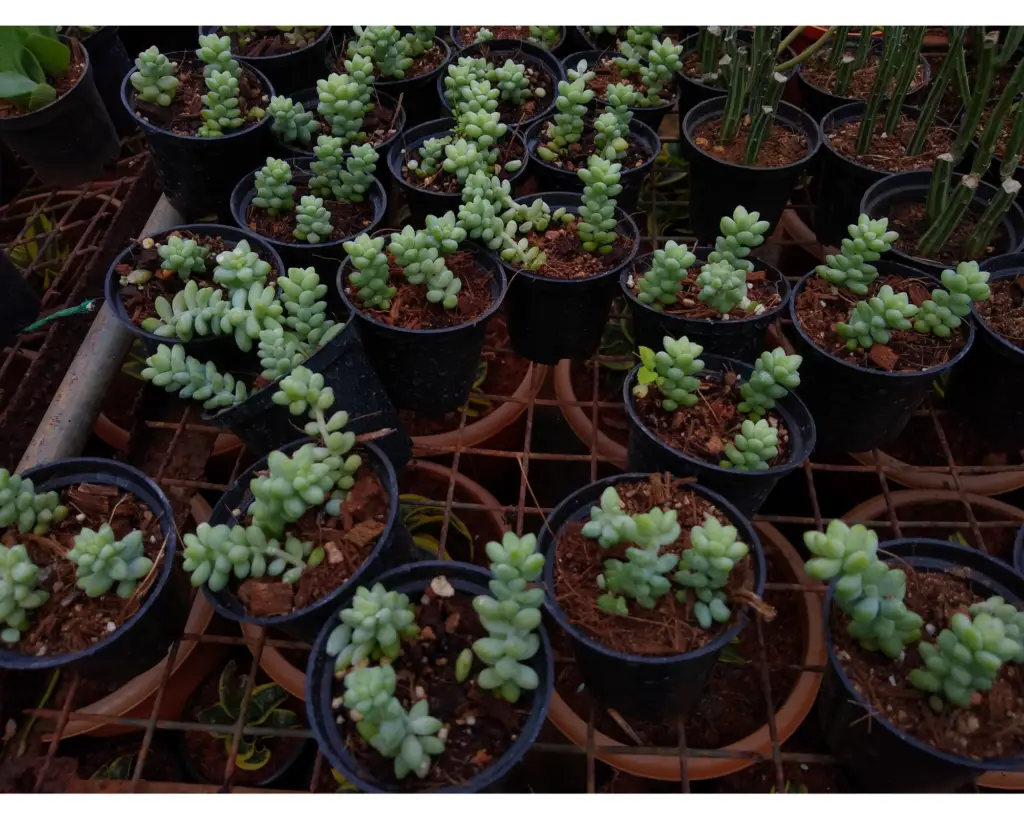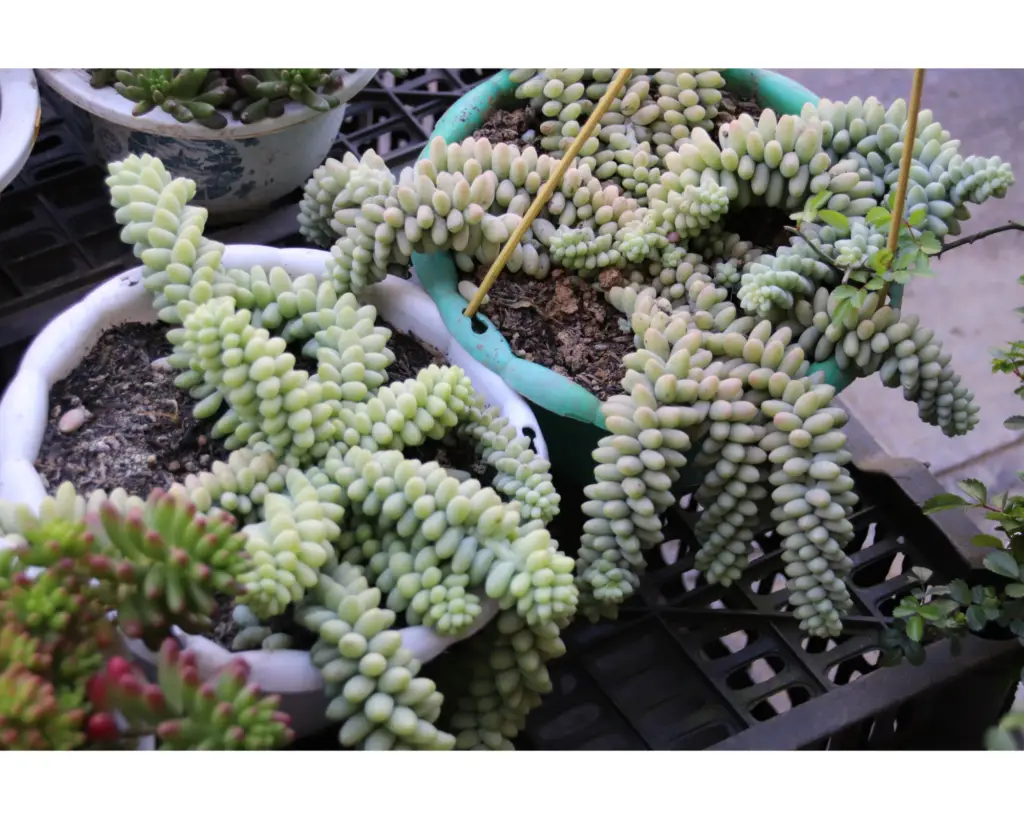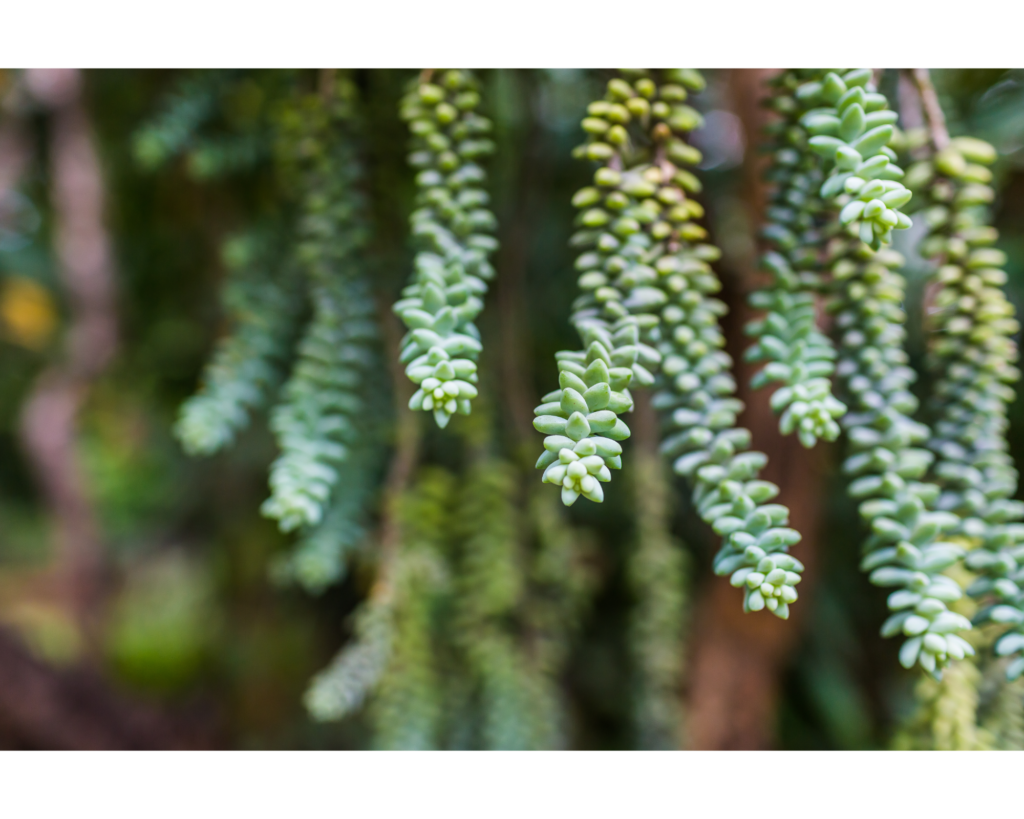Burro’s Tail or Donkey’s Tail (Sedum morganianum), is a popular houseplant that’s loved for its unique appearance and easy-care nature. With its long, trailing stems covered in plump, grey-green leaves, it’s easy to see why this plant is so popular. We’ll take a closer look at Burro’s Tail and explore what makes it such a great houseplant, its care requirements so that it thrives in your home.

What is Burro’s Tail?
Burro’s Tail, or Sedum morganianum, is a trailing succulent that’s native to southern Mexico and Honduras. It belongs to the family Crassulaceae, which also includes other popular houseplants like Jade Plants, String of Pearls, and Echeverias. The plant gets its name from its long, trailing stems that can grow up to three feet (0.9 metres) in length. These stems are covered in small, plump, grey-green leaves that give the plant a unique and interesting appearance.
Burro’s Tail is a slow-growing plant that can live for many years with proper care. It’s a great plant for beginners as it’s easy to care for and doesn’t require a lot of attention. In fact, the plant is known for being quite resilient and can tolerate a variety of growing conditions.
Why is Burro’s Tail a great houseplant?
There are many reasons why Burro’s Tail has become such a popular houseplant in recent years. Here are just a few of the reasons why you should consider adding one to your collection:
- Low-maintenance: Burro’s Tail is a very easy plant to care for, making it a great choice for beginners or anyone who wants a plant that won’t require a lot of attention. The plant is drought-tolerant and can go several weeks without water, so you don’t have to worry about watering it every day.
- Versatility: Burro’s Tail can be grown in a variety of settings, from hanging baskets to terrariums to pots on a windowsill. It’s also a great plant to use in mixed planters, where its trailing stems can add interest and texture.
- Attractiveness: With its long, trailing stems covered in plump, gray-green leaves, Burro’s Tail is a beautiful plant that can add a touch of whimsy and charm to any room. Its unique appearance is sure to turn heads and start conversations.
- Propagation: Burro’s Tail is a very easy plant to propagate, which means you can easily share it with friends or create new plants for your own collection. Simply take a stem cutting and place it in well-draining soil, and it will quickly root and start growing.


How to care for Burro’s Tail
Now that you know about the Burro’s Tail, let’s take a look at how to care for it to ensure it thrives in your home.
Light and Water
Burro’s Tail prefers bright, indirect light, it should be placed at a window that gets plenty of sunlight but is shaded by a sheer curtain. If the plant doesn’t receive enough light, it may become leggy and lose some of its leaves.
Burro’s Tail is a drought-tolerant plant that doesn’t require a lot of water. In fact, overwatering is one of the biggest mistakes people make when caring for this plant. The soil should dry out completely before watering. Secondly, water thoroughly until water drains out the bottom of the pot. In the winter months, when the plant is dormant, you can reduce watering to once every two to three weeks.
Soil, fertilisation and propagation
To care for Burro’s Tail, use a well-draining soil mix and avoid overwatering, which can lead to root rot. Burro’s Tail is a slow-growing plant that doesn’t require a lot of fertiliser. However, you can give it a boost with a diluted, all-purpose houseplant fertiliser once a month during the growing season. The plant can be propagated easily which should be planted in well-draining soil and kept moist until they root. With proper care, Burro’s Tail can thrive as a beautiful and low-maintenance houseplant.
Common pests and diseases
Like any plant, Burro’s Tail is susceptible to pests and diseases. Common pests that can affect this plant include mealybugs, spider mites, and scale insects. Mealybugs can be observed by identified their cotton-like webbing on the plant, while spider mites cause yellowing and discolouration of the leaves. Scale insects appear as small, brown bumps on the plant’s stems. To control these pests, use insecticidal soap or neem oil. Slso, wipe the affected areas with a cotton swab dipped in rubbing alcohol. Burro’s Tail is also susceptible to root rot if overwatered or if planted in poorly-draining soil. To prevent root rot, make sure the soil is well-draining and avoid overwatering the plant.
Conclusion
In conclusion, Burro’s Tail is a beautiful and low-maintenance house plant that’s perfect for beginners and experienced gardeners alike. With its long, trailing stems covered in plump, grey-green leaves, it’s easy to see why this plant has become so popular in recent years. To care for Burro’s Tail, provide it with bright, indirect light and allow the soil to dry out completely between waterings. Avoid overwatering and make sure the soil is well-draining to prevent root rot. With proper care, Burro’s Tail can thrive as a unique and interesting addition to your indoor garden.
